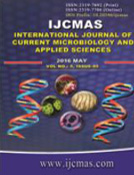


 National Academy of Agricultural Sciences (NAAS)
National Academy of Agricultural Sciences (NAAS)

|
PRINT ISSN : 2319-7692
Online ISSN : 2319-7706 Issues : 12 per year Publisher : Excellent Publishers Email : editorijcmas@gmail.com / submit@ijcmas.com Editor-in-chief: Dr.M.Prakash Index Copernicus ICV 2018: 95.39 NAAS RATING 2020: 5.38 |
E strips used in Epsilometer test (E-test) for antifungal susceptibility testing is a simple, convenient and promising method with broad applications in microbiology. This E-test obtains a reproducible and quantitative MIC reading, with the E strips used that contain a predefined continuous gradient of a drug. The main aim of this study includes comparing the antifungal susceptibility testing of Candida species by E-test and Colorimetric Sensititre YeastOne micro broth dilution (CMBD) methods. This was a cross sectional study, carried out from December 2012 to Nov 2014 from hospitalized patients at a tertiary care centre, in which 50 non-repetitive clinical isolates of Candida were analysed. The antifungal susceptibility testing (AFST) of these isolates was carried out by E-test and Colorimetric micro broth dilution (Sensititre Yeast One- TREK diagnostics), MIC values were interpreted as per CLSI M27-S4 (2012). Out of 50 isolates, 36 (72%) were non-albicans Candida and 14 (28%) were C.albicans. AFST by E-test showed that 24 isolates (48%) were resistant to fluconazole and voriconazole but all were sensitive to amphotericin B. Out of 24 resistant isolates by E-test 12 isolates were subjected to CMBD, showed all were resistant to fluconazole and voriconazole and 05 were sensitive to other azoles (posaconazole, Itraconazole, ketoconazole) and all isolates were sensitive to amphotericin B, caspofungin and 5-flucytosine. We conclude that E-test is the simple, convenient and promising method for antifungal susceptibility testing with excellent correlation with CMBD.
 |
 |
 |
 |
 |